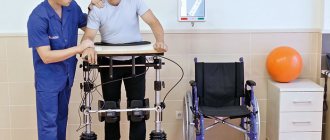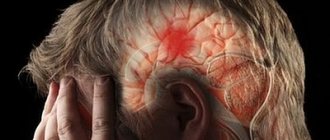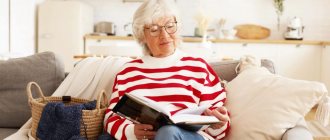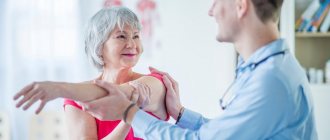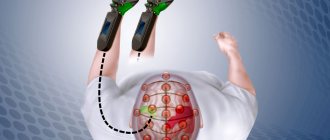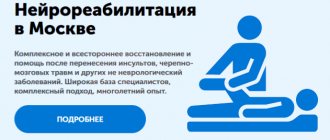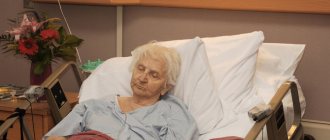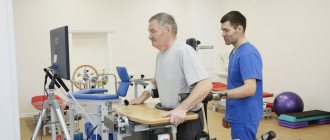Stroke is a serious brain disease characterized by circulatory disorders, focal lesions of brain tissue, and death of neurons. A stroke can be hemorrhagic or ischemic. Hemorrhagic stroke is less common than ischemic stroke and is characterized by rupture of blood vessels and hemorrhage in brain tissue. Ischemic stroke is more often diagnosed in older people and is characterized by impaired blood flow in the cerebral arteries and the death of neurons in the area of blood supply to brain tissue by the affected artery. When a stroke develops, the patient requires emergency care: the sooner the patient is admitted to the hospital, the more effective the care provided by doctors will be.
In addition to drug treatment of stroke, great importance is attached to rehabilitation therapy, which begins to be carried out in the acute period of the disease. At the Yusupov Hospital, various methods of physiotherapy and exercise therapy are used to restore patients after a heart attack and stroke. With the help of a comprehensive rehabilitation program, the patient is rehabilitated - restoration of motor activity, coordination of movements, visual function, sensitivity. The neurorehabilitation department of the hospital is equipped with modern devices, verticalizers and various simulators, including robotic ones.
The influence of exercise therapy on the patient’s nervous system
Therapeutic exercise is the performance of certain physical exercises, which begin with the simplest movements of the patient after he regains consciousness, then the physical activity gradually increases, the exercises become more complex. Exercise therapy helps improve blood circulation in organs and tissues, accelerates the process of restoration of various body functions, and improves metabolism. Physical therapy exercises for each patient are selected individually depending on the severity of the patient’s condition and concomitant diseases. An individual physical therapy program at the Yusupov Hospital is drawn up by a rehabilitation doctor.
Make an appointment
Passive and active rehabilitation after stroke
The first classes with the patient are conducted by a physical therapy instructor in the ward. The patient performs simple movements with his arms and legs with the help of an instructor - this type of rehabilitation is called passive. Passive rehabilitation of the upper and lower extremities begins with the development of large joints with a gradual transition to small joints. Rehabilitation therapy begins with the shoulder and hip joints. After developing the hip joint, the instructor helps the patient flex and extend the lower limb, develops the knee, then the ankle joint, and lastly the doctor develops the joints of the foot.
The rehabilitation specialist performs massage from the foot to the thigh. During hand rehabilitation, exercises begin with the development of the shoulder joint, then flexion-extension and rotational movements of the hands are carried out in the area of the elbow and hand joints. Massage of the upper limbs is performed from the fingers to the shoulder. A set of exercises combined with massage stimulates brain function. With partial restoration of motor function, exercise therapy exercises become more complex, and the patient begins to perform the exercises independently. The time for gymnastics increases from 10 minutes to half an hour, and active rehabilitation of the patient begins.
If the brain damage is significant, the patient is paralyzed, sensitivity is lost, rehabilitation is carried out with the help of medication, massage, electromagnetic stimulation of nerve cells, acupuncture, and reflexology. After partial restoration of motor function, the rehabilitation doctor introduces therapeutic exercises into the program.
Nordic walking
The peculiarity of Nordic walking with poles resembling ski poles is that it allows you to evenly distribute the load across 90% of the muscles of the body. In the same way, it redistributes pressure on the joints. This is important for older people, who often suffer from joint pain in the lower extremities.
We recommend adding Nordic walking to your rehabilitation program after a stroke because it:
- strengthens the cardiovascular and respiratory systems;
- improves coordination of movements and the body’s ability to maintain balance;
- reduces cholesterol levels;
- speeds up metabolism;
- improves mood.
While walking, you need to monitor your breathing - the inhalation time should be almost 2 times less than the exhalation. You also need to monitor your pulse. The heart rate (HR) should be only 30% higher than normal. That is, when walking with poles, you do not need to accelerate much.
The duration of classes is increased gradually, starting from 20 minutes. The length of the stick is calculated as follows: x * 0.65. Where x is your height.
Rehabilitation exercises on simulators
The Yusupov Hospital uses two types of simulators for the rehabilitation of patients after a stroke - mechanical and robotic. Mechanical exercise machines include exercise bikes, treadmills, and exercise machines for restoring balance and gait. Robotic simulators are equipped with electronic biosensors that stimulate activity by influencing the affected limbs. Robotic simulators have wide functionality; they are programmed taking into account the patient’s needs, promote the transmission of nerve impulses from the brain to the injured limb, and stimulate motor activity.
Rehabilitation exercises after a stroke are performed using multifunctional exercise equipment and sports equipment. There are different types of simulators:
- To restore motor activity, use a flexion/extension simulator, a simulator for developing the joints of the limbs, exercise tracks, and exercise bikes.
- For bedridden patients, exercise equipment in the form of a bed or bicycle is used.
- To restore balance, gait, and motor activity, a horizontal simulator is used.
- For patients who cannot yet stand, a seated exercise machine has been created to develop and strengthen the back muscles.
Hand exercises for stroke rehabilitation
Hand exercises improve motor activity and help restore lost functions. In severe cases and in the absence of early rehabilitation, hand functions are often not restored or partially restored. In some cases, rehabilitation does not help; doctors carry out bipolar stimulation - an effect on immobile joints and muscles of the body using artificially created impulses from the brain to the body. This helps restore reflexes and sensitivity, improve blood circulation in the tissues. Then the patient undergoes rehabilitation using exercise therapy and other methods.
The motor activity of the hands and the motor skills of the fingers are most difficult to restore. You can often see trembling hands in a patient after a stroke; he cannot hold a ballpoint pen in his hand, cannot write, and does not grasp objects well. Especially for such patients, they conduct classes in modeling from plasticine, with a Rubik's cube, teach them to write again, and work on a silicone simulator. Doctors use reflexology if a patient has suffered a severe stroke. This helps restore fine motor skills, improve grasping movements, flexion and extension of fingers, and joints of the hand. At the Yusupov Hospital, patients undergo rehabilitation on computerized simulators using a comprehensive recovery program, which includes massage and physical therapy exercises.
Hand exercises are not complicated and do not require special exercise equipment or devices; the patient can perform them at home:
- Lie on the bed, move your arms back and grab the headboard. Tighten the muscles of your arms and body, imitating a pull-up. Raise your legs up or stretch them straight.
- Using rotational movements of bent arms, knead the shoulder joint.
- Sit upright on the bed, place your hands behind your back as close to each other as possible, tilt your head back, then return to your previous position.
How not to harm yourself
If you experience heart/side pain or dizziness while jogging, something has gone wrong. You need to stop, take a breath and count your pulse. Normal number of beats per minute for different ages:
✓ 30 years – 162;
✓ 40 years – 157;
✓ 50 years – 152;
✓ 60 years – 147;
✓ 70 years – 142;
✓ 80 years – 137.
You can't run on a full stomach. While jogging, you need to monitor uniform breathing and correct posture, and periodically reduce the pace.
There are contraindications for jogging:
- atherosclerosis;
- bronchial asthma;
- thrombophlebitis and varicose veins;
- hypertension;
- heart attack suffered earlier than 12 months;
- uncompensated diabetes mellitus;
- stage 3 obesity;
- viral and infectious diseases in the acute stage;
- chronic lung diseases;
- liver cirrhosis etc.
I run correctly after a stroke: technique
When running, the insides of the feet should be parallel to each other, with the toes slightly turned outward. You need to place your foot so that the weight is redistributed from heel to toe. When moving your legs, you need to make sure that your shins are relaxed, that is, the main load falls on your hips and knees.
To reduce wear on the joints, you need to straighten your knees smoothly, do not raise them too high, and do not sway from side to side.
You should move easily, with medium steps, keeping your body vertical (let's say a slight lean forward). Your arms should be bent at right angles, your gaze directed forward about 30 meters. Shoulders and neck need to be relaxed.
Scrupulous execution of the technique will reduce tension in joints and muscles, and also prevent injuries during jogging.
For the shoulder joint
Restoration of the forearm and shoulder joint takes place with the help of flexion and extension exercises, rotation, push-ups, muscle tension and relaxation, clapping, and massage. To do this, use exercise machines, dumbbells, and various devices. First, the arm is kneaded, then a set of exercises is performed; therapeutic exercises are always combined with a massage of the limbs. A set of exercises for the shoulder joint:
- The patient lies on his back, arms extended along the body. The instructor holds his hand at the elbow to avoid bending, takes the patient's palm with his other hand and moves the patient's arm up and down.
- The instructor performs circular movements with the patient's arm fixed in a straightened state.
- The patient lies on his back, with his arm slightly to the side. The instructor turns the straightened arm over, palm down, then up.
For lower limbs
Exercises for the lower extremities begin to be performed as soon as the patient regains consciousness. At the initial stage, the instructor helps to bend and straighten the lower limbs; over time, the patient will be able to imitate walking in a prone position, then get out of bed, learn to maintain balance, and walk without support. Exercises for patients in the supine position:
- The patient is in a supine position, the leg is straightened. The instructor turns the leg with the foot inward, then outward.
- The patient is in a supine position, the leg is bent at the knee. Holding one hand under the knee, the instructor performs circular movements with the limb, holding and pressing with the other hand in the hip joint area.
- The patient is in a supine position, the affected leg is bent at the knee. The instructor fixes the leg at a right angle, holding it with the other hand under the knee, bends and straightens the lower limb.
- The patient is in the same position on his back, with the leg fixed at a right angle. The instructor, holding the patient's leg under the knee, moves it away from the body and returns it back.
These exercises are performed by the patient after he is allowed to sit:
- In a half-sitting position, holding the edges of the bed with both hands, stretch both legs forward as evenly as possible, bend over, throwing your head back. While stretching your limbs, take a deep breath, return to your previous position and exhale.
- Remain in the same body position, keep your breathing calm and deep, slowly lift your right leg up and lower it back, then your left leg.
- In a half-sitting position, bend your leg, pull your bent leg at the knee as close to your chest as possible (you can help with your hands), and tilt your head forward during the exercise. Bending the leg, inhale, straightening the limb, exhale, return to the previous position.
Exercise therapy to restore visual function after stroke
At the Yusupov Hospital, patients with visual impairments will be able to undergo examination, treatment, rehabilitation, and, if necessary, surgical treatment in a network of partner clinics. Rehabilitation after a stroke includes exercises that you can then do at home. Depending on the type of visual impairment, rehabilitation therapy is carried out:
- If lateral vision is impaired, intensive medical and restorative treatment is carried out, undamaged areas of the cerebral cortex take over the lost function, and vision is restored. In this case, the doctor marks with a red line a passage of text on the page of the book on the side of which lateral vision is weakened. Before starting to read, the patient must look for the red line - this will be the beginning of the text.
- With oculomotor nerve palsy, the patient cannot look straight and his eyes look in different directions. Such a disorder can resolve over time with proper and timely treatment and rehabilitation. With paresis of the oculomotor nerve, accommodation may be impaired. Over time, the patient gets used to using only central vision. To determine the impairment of perception of objects at far and near distances, the following test is performed: the doctor takes a pencil in each hand and brings one of the pencils closer to the patient’s face, then moves his hand back.
- If atrophy of the oculomotor nerve develops, the patient's function of the upper eyelid muscle is impaired. Nystagmus or trembling of the eyeballs may occur. Often this condition leads to visual impairment.
To restore vision, the doctor asks the patient to draw the other half of an object in a drawing or take part in a certain type of computer game. The patient is asked to follow with his gaze the pencil in the doctor’s hand, which moves in front of the patient’s face to the right, then to the left, up or down. The patient should follow the pencil without turning his head. To improve blood circulation, eye massage is necessary and beneficial. The eyes are closed, with gentle movements in a circle the patient massages the eyeballs, lightly pressing on them. The exercise should be performed for 10-20 seconds.
To restore visual function, a number of eye exercises are performed:
- Rotate the eye to the right, then to the left - repeat several times.
- Look up, then down - repeat the movement several times.
- Movement of the eyes in a circle - to the right, then to the left.
- Take a short break with your eyes closed, open your eyes and blink frequently for a few seconds.
- Close your eyes tightly and relax - repeat several times.
- Fix your eye on the object, then turn your head to the right and left without taking your eyes off the object - do this several times.
Static and dynamic loads
Static exercises are periodic contractions of the muscles of a limb with an immobilized joint. The arm or leg is in a vertical or inclined position for some time, in a state of tension.
The exercise lasts from a few seconds to 1-2 minutes: the assistant lifts the injured limb, and the patient tries to keep it in the air, tensing the muscles. To enhance the effect, weights are used - barbells, weights. Such exercises are usually carried out at the initial stage of rehabilitation after a stroke.
Dynamic loads after a stroke - running, walking, swimming, cycling. You can start them under the supervision of a specialist (for example, while staying in a rehabilitation center or sanatorium) and continue after returning home.
The benefits of dynamic loads:
- strengthen the cardiovascular system;
- improve the condition of the musculoskeletal system;
- promote weight loss;
- improve your mood.
But there are also contraindications:
- severe cardiovascular diseases;
- diseases of the lungs, blood vessels, blood and the threat of bleeding;
- previous traumatic brain injuries with a risk of increased intracranial pressure;
- parkinsonism, multiple sclerosis, oncology, liver cirrhosis, etc.
The volume of dynamic loads during the rehabilitation period should be adjusted depending on the dynamics of improvements. Over time, the duration of classes increases, complex exercises are added, and their intensity increases.
You shouldn’t suddenly change the tactics of doing exercises - this can cause discomfort in the muscles and joints and cause a deterioration in well-being. For example, the question “Is it possible to play football after a stroke?” should only be asked by your doctor. He will make a decision based on the condition of your body and your ability to tolerate stress during a given period.
Restoring fine motor skills after stroke
Fine motor skills are restored with the help of simple exercises that allow you to restore fine hand movements and finger flexibility. The most effective activities for restoring fine motor skills are putting together puzzles, various objects from small parts of a construction set, drawing, fastening buttons on clothes, and lacing shoes. To restore the function of the hand and fingers, the patient is asked to take two nuts in his hand and roll them with the movement of the palm and fingers. Recommended for patients after a stroke to develop fine motor skills:
- Sort through the beans and peas, separating the peas from the beans.
- Use special silicone hand trainers with spikes to massage your palms and fingers.
- Tighten and unscrew nuts, close and open the lock with a key, turn on and off the lights in the room, write texts.
What not to do after a stroke
During the recovery period after a stroke, you should refrain from heavy physical labor, carrying heavy objects, and excessive activity. Running, swimming or walking should bring cheerfulness and a surge of strength, not fatigue. Bath/sauna, drinking alcohol and smoking, overeating (especially fatty, heavy foods) are also contraindicated.
______________________
Not only the state of a person’s health, but also the likelihood of re-development of the pathology depends on how successful the rehabilitation is. Following your doctor's advice, personal motivation and regular exercise after a stroke will help restore lost brain functions and return to a full life.
Restoring speech after a stroke
Speech function after a stroke is restored much worse than motor function. Its recovery can take a long time, over several years. Speech therapists at the Yusupov Hospital are developing a program and working with the patient to restore speech throughout the entire period of his stay in the hospital; after discharge from the hospital, his relatives are involved in the patient’s rehabilitation. To restore speech, the following techniques are used:
- Pronunciation of an incomplete word - the patient must complete the word independently.
- If speech function is completely lost, rehabilitation begins with the pronunciation of individual sounds.
- When the patient learns to pronounce words, he is forced to repeat short poems and sayings.
- Singing is considered one of the best methods of speech restoration.
- In order for the patient to learn to speak faster, the facial muscles and tongue muscles should be trained. For this purpose, the patient is taught to curl his lips into a tube, stick his tongue out of his mouth as far as possible, and lick his lips with his tongue, first in one direction, then in the other. Lightly bite your lower lip, then your upper lip, and bare your teeth.
Make an appointment
Get there in 4 hours
The main problem of stroke is that patients present to a medical facility too late. After all, the so-called therapeutic window, during which you need to have time to start special therapy, for ischemic stroke is very short - only 4–4.5 hours. During this time, it is necessary to take the victim to a specialized vascular center, perform a CT scan (computed tomography) of the brain, which allows one to diagnose a stroke and determine its type (ischemic or hemorrhagic) and begin the use of intravenous thrombolytic therapy (TLT). Thrombolytic drugs dissolve blood clots that cause blockage of blood vessels in the brain, and in some cases allow not only to save the patient’s life, but also (lo and behold!) to reverse the development of the consequences of a stroke.
If such treatment was carried out within 1.5 hours from the onset of a stroke, 1 patient out of 4–5 has a chance to fully recover, if within 1.5–3 hours, then 1 out of 9. 3 to 4.5 hours, only 1 out of 14 victims will be able to protect themselves from the consequences of a stroke. In other patients, thrombolysis can also lead to improvement, but there are no consequences. That's why it's so important not to waste time. If it is impossible to perform TLT, in some cases the clot can be removed surgically.
Over the past 8 years, the number of systemic thrombolysis procedures for ischemic stroke in Russia has increased more than 10 times. Nevertheless, even today this method is carried out only in 3.7% of cases, while such therapy is indicated for 40% of patients.
Rehabilitation of the patient at home
Before the patient is discharged from the hospital, relatives receive recommendations on caring for the patient after a stroke. Recommendations for rehabilitation will be provided by the attending physician. The rehabilitation exercise program is performed every day without breaks, 2-3 times a day. Performing physical exercises should not tire the patient or cause him pain. Exercises in a sitting position help prepare the patient for walking.
When the condition improves, exercises are performed in a standing position; they help eliminate neurological disorders as much as possible by restoring fine movements. The patient performs exercises with an expander. From a standing position, he bends down and picks up a matchbox from the floor. Performs breathing exercises with raising your arms up while inhaling, standing on your toes, then lowering yourself onto your entire foot, lowering your arms, exhaling, leaning forward. A comprehensive recovery program is aimed at reducing muscle tone, improving blood circulation, preventing joint contracture, restoring and maintaining fine motor skills, speech, preventing the formation of bedsores and the development of inflammatory processes.
The Yusupov Hospital uses modern rehabilitation methods, uses various types of exercise equipment, and physical therapy exercises. Rehabilitation doctors develop an individual rehabilitation program for each patient.
And beyond the Urals it’s better
In Russia, a vascular program has been developing for 10 years, recognized as the best in the world. After all, the presence of almost 600 modern vascular centers allows us to achieve the optimal ratio (30 vascular beds per 150 thousand population) necessary to provide help to all those in need. The best situation with stroke treatment, by the way, is not in Moscow, where due to overpopulation the required number of beds in hospitals is often not enough, but beyond the Urals: in Yekaterinburg, Krasnoyarsk, Kazan.
The availability of TLT therapy for Russian patients is increasing. In particular, because foreign manufacturers of such drugs began to locate their production in Russia. Thus, in February 2021, the production of the first batches of a modern thrombolytic for the treatment of ischemic stroke, pulmonary embolism and myocardial infarction was organized, with production stages partially localized in Russia.
